|
|
|
Sort Order |
|
|
|
Items / Page
|
|
|
|
|
|
|
| Srl | Item |
| 1 |
ID:
117909
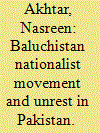

|
|
|
|
|
| Publication |
2011.
|
| Summary/Abstract |
Pakistan is one of the most complex multi-ethnic societies in the developing Islamic world. Each of the ethnic groups that now comprise Pakistan has very distinctive identity, folklore, history and political interests. However, Pakistan's nation builders were not alive to the ethnic question and failed to integrate ethnic groups into a Pakistani nationhood through recognised principles of autonomy, representation and empowerment. Instead, a non-representative, military-led authoritarian system suppressed legitimate regional and ethnic aspirations, relying too heavily on Islam and Pakistan ideology (two nation theory) to forge a sense of common nationhood. It didn't work: since the 1950s there have been four major insurrections against the central government by Baluch nationalists. Although the Baluch national question has its roots in the colonial era, it emerged as a significant political and security issue because an over-centralised and non-representative power system couldn't address the issue of ethnic diversity. Baluchistan is now a hub of interests for regional and major powers.
|
|
|
|
|
|
|
|
|
|
|
|
|
|
|
|
| 2 |
ID:
117908
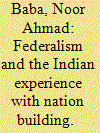

|
|
|
|
|
| Publication |
2011.
|
| Summary/Abstract |
For plural societies like India, the only workable strategy of nation building is to provide all segments of society with an equal sense of belonging, respect and security. The Indian constitutional framework, despite some assimilationist influences, was broadly drawn on accommodationist lines. As a matter of policy, India adopted cultural pluralism rather than an assimilationist brand of cultural nationalism. The Constitution allowed federalism to develop and evolve as a dynamic process, despite certain inbuilt limitations that undermined its functioning in its initial three decades. Nevertheless, there has never been a consensus in India about using special provisions/autonomy as a strategy of nation building or as a mechanism of problem solving. Such an arrangement in the context of Kashmir was seen as an aberration and a potential source of disunity for the country. However, the erosion of Article 370 has undermined rather than promoted the cause of national integration in relation to Kashmir.
|
|
|
|
|
|
|
|
|
|
|
|
|
|
|
|
| 3 |
ID:
117902
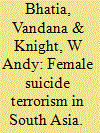

|
|
|
|
|
| Publication |
2011.
|
| Summary/Abstract |
In this article we compare two conflicts in South Asia-civil war in Sri Lanka and the insurgency in Kashmir-to investigate the enabling conditions for female suicide terrorism in the former, and the lack thereof in the latter. We conclude that female suicide terrorism is a product of several inter-related factors that feed into each other: (i) tormented society, (ii) individual grievances, and (iii) a terrorist organisation with an effective indoctrination structure. Thus, rather than focusing on the individual motivations behind the female bombers, it is important to situate them in specific socio-political contexts.
|
|
|
|
|
|
|
|
|
|
|
|
|
|
|
|
| 4 |
ID:
117910
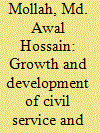

|
|
|
|
|
| Publication |
2011.
|
| Summary/Abstract |
The aim of this article is to analyse the growth and development of bureaucracy as an institution of government in Bangladesh from historical and politico-administrative perspectives. Although it is now an independent state, various Hindu kings, Muslim emperors, British lords and zamindars of the Indian subcontinent ruled the area of Bangladesh for several hundred years. In 1947, when India and Pakistan emerged as independent states, Bangladesh was a part of Pakistan. To understand the growth and development of bureaucracy in Bangladesh, the article is divided into two broad sections: the colonial legacy of both British India and Pakistan (1601-1971) and the Bangladesh period (1971-2008). The structure and working patterns of bureaucracy in Bangladesh are a legacy of British colonial rule, which impeded reform efforts after Independence and caused politicisation of the administration and governance. Civil-military elitisms reduced accountability of the administration, resulting in a dominating bureaucratic structure with corruption.
|
|
|
|
|
|
|
|
|
|
|
|
|
|
|
|
| 5 |
ID:
117905
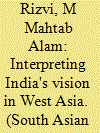

|
|
|
|
|
| Publication |
2011.
|
| Summary/Abstract |
India and Iran frequently cite the civilisational, cultural and historical ties that have bound the two countries together for more than a millennium. Both nations enjoyed strong bilateral relations following India's independence, overcoming such hindrances as Cold War politics and Iran's relationship with Pakistan. Iran and India enjoy friendly and consolidated ties that have led to greater stability in the region. The swiftly changing international surroundings and the associated strategic dimensions have been catalysts in forcing the two countries to reorient their foreign policies towards each other. However, much needs to be done to give economic and political support for a long term strategic direction to the bilateral relationship. This article seeks to capture the emerging orientation of India's relations with West Asia in general and Iran in particular. The article also examines the political, economic, cultural and security dimensions of the evolving relationship between India and Iran.
|
|
|
|
|
|
|
|
|
|
|
|
|
|
|
|
| 6 |
ID:
117904
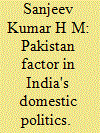

|
|
|
|
|
| Publication |
2011.
|
| Summary/Abstract |
Overt acquisition of nuclear weapons capacity by India and Pakistan in May 1998 signalled a tectonic shift in the nature of subcontinental conflicts. India's military superiority in the region and its strategic depth got considerably weakened due to Pakistan's attainment of strategic parity vis-à-vis India. In the wake of overt nuclearisation, the logic of nuclear deterrence in subcontinental security dynamics was also questioned because of continued security instability, evident in instances like the military impasse of 2001-2002. Hence, the subject of nuclearisation of subcontinental security began to capture wider spaces in the political debates in India. This strategic decision, having been taken by a coalition government, imparted enormous complexities to the domestic political exchanges over the security dynamics of the subcontinent. It also drastically transformed the nature and content of India's domestic politics, as it brought strategic issues and foreign policy agenda of the government into the political parlance of the common people.
|
|
|
|
|
|
|
|
|
|
|
|
|
|
|
|
| 7 |
ID:
117906


|
|
|
|
|
| Publication |
2011.
|
| Summary/Abstract |
India's policy orientation towards its immediate neighbouring countries in South Asia has been subjected to analyses mainly through the prism of foreign policy. In this article, neighbourhood is taken as a prism to categorise the phases of India's policy since Independence towards these countries. In this effort, certain trends have been identified in Indian foreign policy that cut across chronology of Indian governments in office. The article critically interrogates the Indian policy package towards India's immediate neighbours through interest based strategies that suit the changing external international political milieu. The Cold War years, the contradictory pulls of economic globalisation and regionalism and the drive towards global multipolarity affected the policy orientations of India towards its neighbours. The article concludes that the political logic of neighbourhood policy of India in South Asia is conditioned by adhocism.
|
|
|
|
|
|
|
|
|
|
|
|
|
|
|
|
| 8 |
ID:
117911
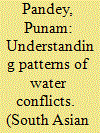

|
|
|
|
|
| Publication |
2011.
|
| Summary/Abstract |
The article underlines the importance of water as a resource which is very unevenly distributed on Earth. Asia is a water deficit region in which 36 per cent of Earth's water is available for 60 per cent of the world's population. The disturbing aspect is how water's unequal distribution, spatially as well as temporally, engenders different kinds of conflicts in the region. In some cases, water becomes a latent factor in causing other conflicts. The conflicts over resources, particularly over water, are couched in different dimensions of politics. The article discusses various types of water conflicts and argues about the limitations of the managerial approach to the understanding of water conflicts. There is a need to deconstruct the social dimension of water usage and the politics behind its sharing at all levels.
|
|
|
|
|
|
|
|
|
|
|
|
|
|
|
|
| 9 |
ID:
117903
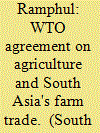

|
|
|
|
|
| Publication |
2011.
|
| Summary/Abstract |
This study seeks to examine the impact of the Agreement on Agriculture (AoA) of the World Trade Organization (WTO) on the balance of agricultural trade of South Asian countries (SAC). The evidence suggests that AoA has failed to boost the SAC farm trade surplus. SAC, as a whole, are net losers in new trade regime. Further, analysis indicates that under the WTO regime, openness of Indian, Sri Lankan and Bangladeshi agriculture has increased. In sharp contrast, Pakistan's agricultural economy has been gradually closed up. The need of SAC is to designate their food items as special products and to create an effective and proactive special safeguard mechanism for safeguarding their food security base, in order to shield the livelihood of millions of resource poor farmers from frequent farm imports surges.
|
|
|
|
|
|
|
|
|
|
|
|
|
|
|
|
|
|
|
|
|